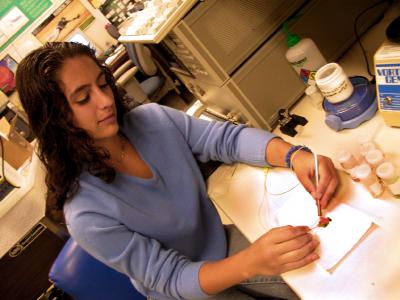August 7, 2003
Young UW scientist meets Nobel laureates
Spending time with 13 Nobel Prize winners would be an exhilarating experience for any young scientist, and Summer Lockerbie Randall is no exception. But the UW doctoral student in chemistry got nearly as big a kick from rubbing elbows with hundreds of her future colleagues.
Randall was one of 27 students from the United States and one of the 18 sponsored by the Department of Energy to make the trek to Lindau, Germany, from
June 30 to July 4 for the 53rd international convention of Nobel laureates.
“I was a little worried that the other students going with me, and all the Nobel laureates, would be interested only in medicine. But that really wasn’t the case,” she said.
Since 1951, Nobelists have met each year in Lindau for open and informal meetings with students and young researchers from around the world. They rotate by discipline — chemistry, physics and physiology/medicine.
This year the focus was medicine — not Randall’s specialty. She works in the UW Center for Process Analytical Chemistry, where she uses a technique called optical low-coherence reflectometry to help solve problems in industrial processes, such as in the manufacture of pharmaceuticals.
The center works with several national laboratories and a number of industrial sponsors — drug and food companies, oil and tire companies, a major airplane manufacturer — looking for ways to improve various manufacturing processes. Eventually she hopes to work in industry or for a national laboratory, developing new technologies to improve process measurements.
So it would seem that Randall, with her background in process chemistry, had little in common with Hamilton Smith when she sat down to dinner with the man who won the Nobel in physiology for the discovery of restriction enzymes. That discovery paved the way for all genomic research done today, but Smith’s award came in 1978, the year before Randall was born.
However, she found he — like the other laureates — was quite willing to talk about family, about the research that led to the Nobel, and about the different research interests since then. The laureates also were interested in hearing about what the students were working on, she said.
“These are the most prominent scientists in the world, but I came out of it seeing them more as colleagues than as gods. That surprised me. I didn’t expect that at all,” she said.
Randall, who grew up in Juneau, Alaska, was one of more than 550 students from 36 countries who had to share the 13 Nobelists for the five days. However, the students from the United States had additional opportunities for small-group sessions with the laureates.
She also found it exciting to share ideas with the other students, whom she sees as her future colleagues and, perhaps, collaborators.
“Getting to know them will probably enhance my career even more than meeting the Nobel laureates,” she said. “It was amazing to see the ties their research had to mine, even though we’re in completely different fields. I’m excited to try a few new ideas in the lab.”



